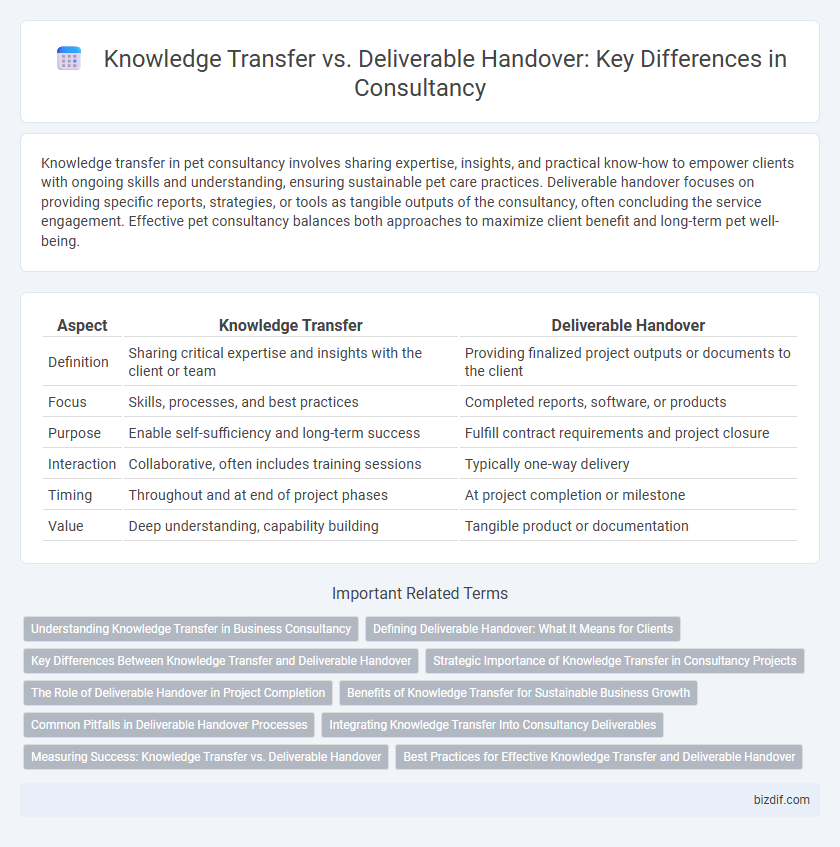Knowledge transfer in pet consultancy involves sharing expertise, insights, and practical know-how to empower clients with ongoing skills and understanding, ensuring sustainable pet care practices. Deliverable handover focuses on providing specific reports, strategies, or tools as tangible outputs of the consultancy, often concluding the service engagement. Effective pet consultancy balances both approaches to maximize client benefit and long-term pet well-being.
Table of Comparison
| Aspect | Knowledge Transfer | Deliverable Handover |
|---|---|---|
| Definition | Sharing critical expertise and insights with the client or team | Providing finalized project outputs or documents to the client |
| Focus | Skills, processes, and best practices | Completed reports, software, or products |
| Purpose | Enable self-sufficiency and long-term success | Fulfill contract requirements and project closure |
| Interaction | Collaborative, often includes training sessions | Typically one-way delivery |
| Timing | Throughout and at end of project phases | At project completion or milestone |
| Value | Deep understanding, capability building | Tangible product or documentation |
Understanding Knowledge Transfer in Business Consultancy
Knowledge transfer in business consultancy involves the systematic sharing of expertise, insights, and contextual understanding between consultants and clients to ensure sustainable growth and informed decision-making beyond project completion. Unlike deliverable handover, which focuses merely on transferring final outputs or reports, effective knowledge transfer embeds critical skills and methodologies within the client's team, fostering long-term capability building. This process enhances organizational learning and operational efficiency by integrating consultancy knowledge into everyday business practices.
Defining Deliverable Handover: What It Means for Clients
Deliverable handover in consultancy refers to the formal transfer of completed project outputs, such as reports, models, or systems, from consultants to clients, marking the conclusion of key project phases. It ensures clients receive tangible, agreed-upon results that meet pre-established criteria and facilitates clarity on project scope, expectations, and ownership. This process establishes accountability, allowing clients to fully utilize the deliverables for their operational or strategic objectives.
Key Differences Between Knowledge Transfer and Deliverable Handover
Knowledge transfer involves the systematic sharing of expertise, insights, and best practices to ensure ongoing capability within an organization, whereas deliverable handover focuses solely on the provision of completed project outputs or documents. Knowledge transfer emphasizes continuous learning and skill development through training sessions, documentation, and mentoring, while deliverable handover is a one-time event marking the end of a project phase. The key difference lies in knowledge transfer enabling sustainable operational efficiency, whereas deliverable handover primarily serves as proof of project completion.
Strategic Importance of Knowledge Transfer in Consultancy Projects
Effective knowledge transfer in consultancy projects ensures sustainable client growth by embedding critical insights, methodologies, and expertise within the organization, surpassing the temporary value of deliverable handover. This strategic process fosters long-term capability development, enabling clients to adapt, innovate, and independently solve future challenges. Prioritizing knowledge transfer enhances project impact, client satisfaction, and strengthens partnerships by delivering enduring organizational value beyond tangible outputs.
The Role of Deliverable Handover in Project Completion
Deliverable handover is a critical phase in consultancy projects, marking the formal transfer of completed outputs to the client and ensuring alignment with contractual requirements. It involves comprehensive documentation, verification of deliverable quality, and client acceptance, which collectively minimize risks and facilitate smooth project closure. Effective handover strengthens client confidence, supports post-project support, and enables measurable value realization from consultancy engagements.
Benefits of Knowledge Transfer for Sustainable Business Growth
Knowledge transfer in consultancy enables organizations to internalize expertise, fostering continuous innovation and reducing dependency on external consultants. Unlike mere deliverable handover, it equips teams with critical skills and insights for effective decision-making and problem-solving, driving long-term business resilience. Sustained knowledge retention accelerates operational efficiency and adaptability, supporting scalable growth and competitive advantage.
Common Pitfalls in Deliverable Handover Processes
Common pitfalls in deliverable handover processes include inadequate documentation, unclear communication channels, and lack of stakeholder engagement, which often lead to misunderstandings and rework. Insufficient knowledge transfer during handover results in gaps that affect project continuity and team performance. Establishing standardized procedures and thorough onboarding materials mitigates risks associated with incomplete deliverable transitions.
Integrating Knowledge Transfer Into Consultancy Deliverables
Integrating knowledge transfer into consultancy deliverables ensures that clients gain sustainable value beyond project completion by embedding training sessions, documentation, and interactive workshops directly within the final outputs. This approach facilitates seamless adoption of recommendations and empowers client teams with practical expertise, reducing dependency on external consultants. Effective knowledge transfer enhances the long-term impact of consultancy services, promoting continuous improvement and organizational resilience.
Measuring Success: Knowledge Transfer vs. Deliverable Handover
Measuring success in consultancy requires distinct approaches for knowledge transfer and deliverable handover, with knowledge transfer focusing on assessing client capability improvement and long-term skill retention through feedback and performance metrics. Deliverable handover success is quantified by the completeness, accuracy, and usability of the final product, often validated by client acceptance criteria and predefined benchmarks. Effective evaluation combines qualitative insights from training outcomes with quantitative analysis of deliverable adherence to project specifications.
Best Practices for Effective Knowledge Transfer and Deliverable Handover
Effective knowledge transfer in consultancy involves structured documentation, interactive training sessions, and ongoing support to ensure client teams fully understand project insights and methodologies. Deliverable handover should include comprehensive review meetings, clear acceptance criteria, and detailed user guides to guarantee smooth transition and usability of the final outputs. Employing standardized templates and checklists enhances consistency, reduces risks, and fosters client confidence during both knowledge transfer and deliverable handover phases.
Knowledge transfer vs Deliverable handover Infographic

 bizdif.com
bizdif.com